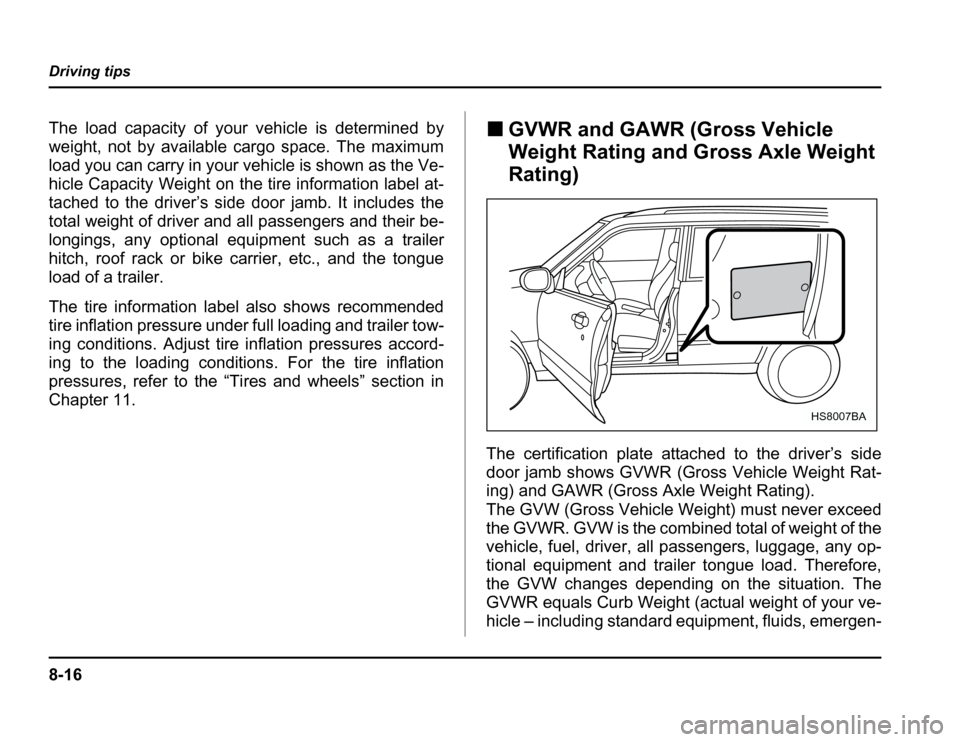Page 229 of 420
6-18
Interior equipment
Shopping bag hook
A shopping bag hook is attached to each side of the
cargo area.
To use the hook, pull the lower portion out.
Do not hang items on the shopping bag hook
that weigh 2.2 lbs (1 kg) or more.
Cargo tie-down hooks
The cargo area is equipped with four tie-down hooks
so that cargo can be secured with a cargo net or ropes.
When using the hooks, raise them. When not in use,
lower the hooks.
The cargo tie-down hooks are designed only for
securing light cargo. Never try to secure cargo
that exceeds the capacity of the hooks. The
maximum load capacity is 44 lbs (20 kg) per an
HS6046BAHS6047BA
Page 270 of 420

8-1
8
Driving tips
New vehicle break-in driving – the first
1,000 miles (1,600 km) ................................. 8-2
Fuel economy hints ..................................... 8-2
Engine exhaust gas (Carbon monoxide) .. 8-3
Catalytic converter ...................................... 8-4
Periodic inspections ................................... 8-5
Driving in foreign countries ........................ 8-5
Driving tips for AWD vehicles .................... 8-6
Off road driving ........................................... 8-7
Winter driving .............................................. 8-9 Operation during cold weather ...................... 8-9
Driving on snowy and icy roads .................... 8-11
Corrosion protection ...................................... 8-12
Snow tires ........................................................ 8-12
Tire chains ....................................................... 8-13
Rocking the vehicle ........................................ 8-13
Loading your vehicle .................................. 8-14 Vehicle capacity weight .................................. 8-15
GVWR and GAWR (Gross Vehicle Weight
Rating and Gross Axle Weight Rating) ......... 8-16
Roof rail and crossbar (if equipped) ............. 8-17
Trailer hitch (if equipped) ........................... 8-22 Connecting a trailer ........................................ 8-22
When you do not tow a trailer ........................ 8-24
Trailer towing ............................................... 8-25 Warranties and maintenance ......................... 8-25
Maximum load limits ....................................... 8-25
Trailer hitches ................................................. 8-30
Connecting a trailer ........................................ 8-31 Trailer towing tips ........................................... 8-32
Page 284 of 420
8-15
Driving tips
– CONTINUED –
can change the way your vehicle handles. This
could result in loss of control and cause per-
sonal injury. Also, overloading can shorten the
life of your vehicle. �Do not place anything on the extended cargo
area cover. Such items could tumble forward in
the event of a sudden stop or a collision. This
could cause serious injury.
Do not carry spray cans, containers with flam-
mable or corrosive liquids or any other danger-
ous items inside the vehicle.
NOTE
For better fuel economy, do not carry unneeded
cargo. �
Vehicle capacity weight
HS8006BA
HS8024BA
Page 285 of 420

8-16
Driving tips
The load capacity of your vehicle is determined by
weight, not by available cargo space. The maximum
load you can carry in your vehicle is shown as the Ve-
hicle Capacity Weight on the tire information label at-
tached to the driver’s side door jamb. It includes the
total weight of driver and all passengers and their be-
longings, any optional equipment such as a trailer
hitch, roof rack or bike carrier, etc., and the tongue
load of a trailer.
The tire information label also shows recommended
tire inflation pressure under full loading and trailer tow-
ing conditions. Adjust tire inflation pressures accord-
ing to the loading conditions. For the tire inflation
pressures, refer to the “Tires and wheels” section in
Chapter 11.
�
GVWR and GAWR (Gross Vehicle
Weight Rating and Gross Axle Weight
Rating)
The certification plate attached to the driver’s side
door jamb shows GVWR (Gross Vehicle Weight Rat-
ing) and GAWR (Gross Axle Weight Rating).
The GVW (Gross Vehicle Weight) must never exceed
the GVWR. GVW is the combined total of weight of the
vehicle, fuel, driver, all passengers, luggage, any op-
tional equipment and trailer tongue load. Therefore,
the GVW changes depending on the situation. The
GVWR equals Curb Weight (actual weight of your ve-
hicle – including standard equipment, fluids, emergen-
HS8007BA
Page 286 of 420

8-17
Driving tips
– CONTINUED –
cy tools and spare tire assembly) plus the vehicle
capacity weight.
In addition, the total weight applied to each axle
(GAW) must never exceed the GAWR. The front and
rear GAWs can be adjusted by relocating luggage in-
side the vehicle.
Even if the total weight of your luggage is lower than
the vehicle capacity weight, either front or rear GAW
may exceed the GAWR, depending on the distribution
of the luggage.
If you carry heavy loads in the vehicle, you should con-
firm that GVW and front and rear GAWs are within the
GVWR and GAWR by putting your vehicle on a vehi-
cle scale, found at a commercial weighing station.
Do not use replacement tires with a lower load range
than the originals because they may lower the GVWR
and GAWR limitations. Replacement tires with a high-
er load range than the originals do not increase the
GVWR and GAWR limitations. �Roof rail and crossbar (if equipped)
The roof rail is not designed to carry cargo by itself.
Cargo can be carried after securing the roof crossbar
kit to the roof rail and installing the appropriate carry-
ing attachment. When installing the roof crossbar kit,
follow the manufacturer’s instructions. When you carry cargo on the roof using the roof cross-
bar kit and a carrying attachment, never exceed the
maximum load limit explained below. You should also
be careful that your vehicle does not exceed the Gross
Vehicle Weight Rating (GVWR) and front and rear
Gross Axle Weight Rating (GAWR). See the “Loading
your vehicle” section in this chapter for information on
loading cargo into or onto your vehicle. The maximum
load limit of the cargo, crossbars and carrying attach-
ment must not exceed
150 lb. (68 kg). Place the
heaviest load at the bottom, nearest the roof, and
evenly distribute the cargo. Always properly secure all cargo.
� For cargo carrying purposes, the roof rail
must be used together with a roof crossbar kit
and the appropriate carrying attachment. The
roof rail must never be used alone to carry car-
go. Otherwise, damage to the roof or paint or a
dangerous road hazard due to loss of cargo
could result.� When using the roof crossbar kit, make sure
that the total weight of the crossbars, carrying
attachment and cargo does not exceed the
maximum load limit. Overloading may cause
damage to the vehicle and create a safety haz-